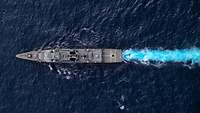
Indo-Pacific Deployment 2021
Germany is showing maritime presence in the Indo-Pacific region with its frigate “Bayern”.


In the Indo-Pacific, German frigate “Bayern” meets other nations not only in ports. Passing exercises at sea are part of naval diplomacy and are the core mission of her voyage to show the flag.
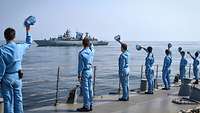
Still a good 12,000 nautical miles and ten weeks away from the port of Tokyo: Germany meets Japan in the Indian Ocean.
JMSDF“I feel honoured to have been able to work with the German Navy,” said Commander Takeshi Kumashiro. The commanding officer of the Japanese destroyer “Yuugiri” thus praised meeting with the German frigate “Bayern” on 29 August in the middle of the Gulf of Aden. Germany and Japan are not official military allies, but friendly nations with comparable values and interests. So the crews used the encounter of the two ships joint seamanship and military exercises – a practical expression of political solidarity.
“Through this training we improved our tactical skills,” Kumashiro says. In addition, the Maritime Self Defense Force stated that in this way and despite the COVID-19Coronavirus Disease 2019 pandemic, it is deepening cooperation with Germany’s naval forces “in order to realize a Free and Open Indo-Pacific, safeguards the peace and security of Japan, and contributes to support stability in the Indo-Pacific region.”
“Up to now, I haven’t been able to exercise with the Japanese navy, so this was also a great honour for me personally,” says Commander Tilo Kalski, commanding officer of the “Bayern”. The very good preparation of the exercise by Kumashiro’s crew also made the collaboration extremely easy, Kalski adds.
In addition to professionalism, a so-called steampast is part of military etiquette and customs at the end of joint exercises like these. The crews of the ships line up on deck and wave to each other while the “leaving” ship passes the ship “to be left” from astern. At the conclusion of this exercise, Kumashiro surprised everyone on “Bayern’s” bridge over the radio with “fantastic German”, according to Kalski. “That touched us all very much.”
He says he was sorry that he could not return this kindness in Japanese. After all, it is occasions like this that make their mission in the Indo-Pacific tangible and meaningful for the crew of the German ship.
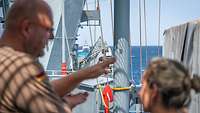
Steaming in formation is a quasi-fixed component of passing exercises. However, warships do not usually sail so closely side by side or behind each other as if for parades, even if it looks like drill on barracks grounds.
Bundeswehr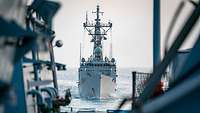
There are solid tactical reasons for the “fleet ballet”: here the “Navarra” astern of the “Bayern”, at a distance of 1,000 yards. From this position, the Spanish frigate can quickly switch to one side or the other of the German ship.
Bundeswehr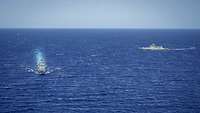
The quick and precise tactical change of position is enormously important within a naval task group in order to be able to react flexibly to threats. Here, Indian frigate “Trikand” to port astern of “Bayern”
BundeswehrThe training took the form of a so-called passing exercise lasting several hours. In military terms PASSEX for short, NATONorth Atlantic Treaty Organization describes these as training occasions between two or more navies consisting of partial exercises in navigation and communication while ships manoeuvre alongside and around each other.
Such bi- and multinational training increases the operational capability and interoperability of the participating warships. Or as the relevant NATONorth Atlantic Treaty Organization regulation states: “The principal reason for exercising ships of the Allied nations as a force is to ensure the highest attainable degree of coordination and teamwork in the conduct of naval warfare against a common enemy.”
In addition, PASSEXs may include sub-exercises such as: person-overboard, boarding, cross-deck flight operations, steaming in tactical formation as well as other communications and data link exercises. The latter include both signalling by Morse signal lamp and flag signals as well as confidential exchange of operational data between command and control systems of the involved ships’ combat information centres.
PASSEXs differ from regular larger exercises primarily in that they are arranged at comparatively short notice, as soon as it is foreseeable that two or more allied or at least friendly warships will meet on their respective paths. That is why they usually last only a few hours – another difference to large naval exercises, which usually last up to two weeks and require several months of meticulous preparation.
At the same time, all this means that two different warships are already sufficient for this type of naval training. Even individual maritime patrol aircraft or submarines are valued as serious “playmates” for a military vessel.
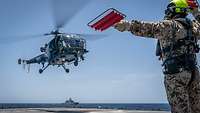
The pilots of the ship’s helicopters can practise cross-deck flight operations, i.e. reciprocal landings on foreign flight decks. Here the helicopter of Indian frigate “Trikand” over “Bayern’s” flight deck
Bundeswehr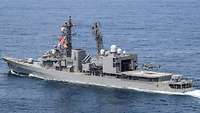
One of the two German helicopters embarked on “Bayern” landing on Japanese destroyer “Yuugiri”. The naval aviators not only learn how flight decks can differ in detail from warship to warship, ...
Bundeswehr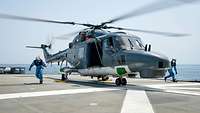
... but also experience how exactly others apply the standardised procedures in detail – as in this case the Japanese flight deck crew.
JMSDFThe manual for the partial exercises of PASSEXs as well as large naval exercises is the Allied Maritime Above Water Warfare Exercise Manual, AXP-2 for short. These common allied regulations define the training standards that all NATONorth Atlantic Treaty Organization warships are to fulfil. The AXP-2 is a classified document, but its non-confidential portions are published in MXP-2, a multinational unclassified manual that allows NATONorth Atlantic Treaty Organization vessels to train jointly with those of third partner nations – such as Japan, Australia or South Korea.
“The MXP-2 generally concerns procedures that are less tactical in nature and more focused on navigational, nautical and seamanship training,” Kalski explains. Through their common links to the USUnited States Navy, many Western navies have similar procedures. In individual PASSEXs, one quickly learns differences, but also commonalities that matter.
“Bayern’s” First Operations Officer, Lieutenant Commander Ulrike B., qualifies this once more: “It becomes difficult, however, especially when a certain degree of interoperability is required in order to carry out certain exercises. This includes above all communications via radio and the exchange of the situational pictures via tactical data links.”
B. is responsible for the combat information centre (CIC), the military-tactical brain of the frigate. “Even if it’s at short notice: you have to seize the opportunity for a PASSEX when it presents itself,” she explains. “If time is short for planning, then it’s best to have talked to everyone on board beforehand and know exactly: which sub-exercises would still be good for the training of, for example, the bridge watch officer students or my operators’ team?”
A big advantage of the many possible individual drills that the MXP-2 includes for these COVID-19Coronavirus Disease 2019 times is that planners can pick out exactly those parts that can also run without contact. Or better: they can avoid those drills that require face-to-face contact; because modern warships usually cooperate practically at long distances in some cases anyway.
“In times of the pandemic, it is nevertheless a pity that we can no longer express our seafaring pride and mutual respect by visiting each other on board,” says B. “Such cross-pooling is, after all, the usual exchange of sailors at sea to each other’s ships. That’s always a highlight with PASSEXs, but it makes up only the smallest part overall.”
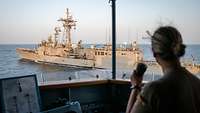
Important training for young watch officers are approaches for replenishment-at-sea. The ships come very close to each other for this kind of manoeuvre, and the team leaders on the two bridges have to concentrate on steaming accurately.
Bundeswehr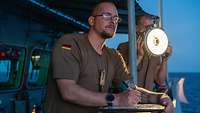
A seemingly simple exercise: Morse coding by light. Precisely because it is so low-tech, it still is of significance for modern warships as a safe fall-back option.
Bundeswehr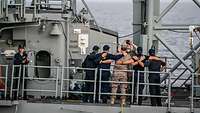
There may be no mutual visits on board in times of the pandemic – but there are still opportunities for souvenir photos. As shown by Spanish sailors on “Navarra” using the “Bayern” as a background.
BundeswehrWith sometimes only a few days in advance of a PASSEX, there is a lot to prepare for B. and her team of almost 30. The operators are usually in charge of the planning. They exchange and evaluate telex messages with precise instructions and prepare briefings. In short: “They knit together an operational plan,” as B. says. “Sometimes it is not enough to carry out a partial exercise with just a normal sea watch of nine people in the CIC, then we increase the staffing and sit with the full combat crew in our ‘basement’.”
It is no coincidence that “Yuugiri” and “Bayern” had their PASSEX in the Arabian Sea of all places. Here, at the north-western end of the Indian Ocean, German, European, and Japanese interests meet. The German warship is on its Indo-Pacific Deployment, supporting the European anti-piracy operation Atalanta in this sea area. The Japanese ship is part of the parallel mission of the multinational Combined Maritime Forces, which are protecting merchant ships in the same area at the Horn of Africa in a quasi-division of labour with Atalanta. “The ‘Yuugiri’ is a very capable warship,” adds Kalski, “which wasn’t chosen for this challenging mission without a reason.”
In general, the international naval presence in the northern part of the Indian Ocean is relatively dense. It is not only maritime trade between Europe and Asia that runs along here. Oil tankers from the Persian Gulf cross into the same sea lanes here, transporting their bunkered raw materials in both directions.
For frigate “Bayern” and her crew, this is noticeable in the number of PASSEXs that are in store for them. Three days before the encounter with “Yuugiri”, the German ship had trained further in the west with the Indian frigate “Trikand” – for the Germans their first binational exercise in the Indo-Pacific area of assignment. One day later, “Bayern” had met the flagship of Operation Atalanta, the Spanish frigate “Navarra”.
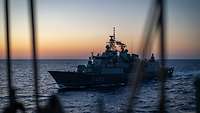
Part of practically every PASSEX: The naval vessels say goodbye with a so-called steam past at the end of the exercises. Here, Greek frigate “Hydra” passes the “Bayern”.
Bundeswehr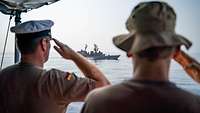
Such gestures of military courtesy are viable between all warships, whether allied or not. First, a formal military salute by raising the hand to the hat, like the Commanding Officer and the Executive Officer of the “Bayern”, ...
Bundeswehr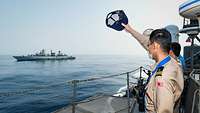
... and then it is permitted to wave. Preferably with the cap, so that it can be seen better. Here, Commander Kumashiro of the Japanese "Yuugiri" returns the Germans saluting.
JMSDFAfter a rather quiet working week following the German-Japanese PASSEX, the exercises continued with a replenishment-at-sea manoeuvre with a USUnited States aircraft carrier task group; and then again joint training with a Pakistani and an American warship. For the remaining months of their Indo-Pacific Deployment 2021, it will be a similar story for the men and women on the “Bayern”.
“PASSEXs are the focus of our Indo-Pacific Deployment,” Kalski concludes. They were also the core of the German frigate’s mission. On these occasions, he says, the crew could demonstrate and develop their skill, and so can the capabilities of the German Navy. “An automatically generated reporting point on the electronic nautical chart may be a form of presence in these waters – but this presence can only settle itself as such in the minds of the partner nations by direct cooperations.”
by Mark Dopitz email